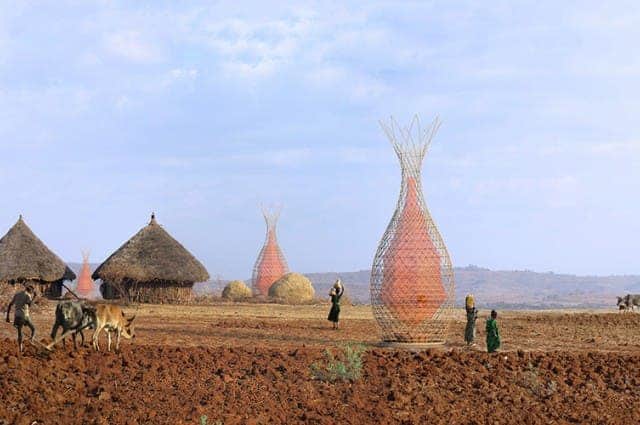
Artist impression of how two such tower might look like in a desert community. Photo: Architecture and Vision
The Namib desert is one of the vastest and driest deserts in the world. There is little water to be found here, so the few critters calling the desert home had to learn to adapt in order to survive. One particular beetle species stands out through the ingenuity with which it manages to quench its thirst – it doesn’t need to find water, it gathers it. Because temperature variations are very high in the Namib (the day time is scorching how, while nights can be freezing), the beetle condenses water on its back until drops roll down into the insect’s mouth. Remarkably simple and effective.
What can remote communities with little access to clean water learn from the Namib beetle? Clearly, humans need more than a few drops of water to survive, but Arturo Vittori, an industrial designer, and his colleague Andreas Vogle claim that they have designed a water condensing tower that is cheap, easy to build and potentially effective at gathering water. Called the Warka Tower, The 9 meter tall construction could potentially gather as much as 100 liters of water during the night, depending on temperature variations and humidity. Nothing less of a godsend for some of the one billion water-deprived people living in the world.
The invention doesn’t involve any complicated gadgetry. Heck, it doesn’t even need electricity to power anything inside. Instead, it lets nature do all the work for it, while the design, carefully chosen to the last curve and bit of material, ensures a steady collection of water.
The self condensing water tower
The rigid outer housing of each tower is comprised of lightweight and elastic juncus stalks, woven in a pattern that offers stability in the face of strong wind gusts while still allowing air to flow through. A mesh net made of nylon or polypropylene, which calls to mind a large Chinese lantern, hangs inside, collecting droplets of dew that form along the surface. As cold air condenses, the droplets roll down into a container at the bottom of the tower. The water in the container then passes through a tube that functions as a faucet, carrying the water to those waiting on the ground.
Now, I don’t want to get any one’s hope up right away, since the project has yet to be practically proven and considering it’s not the first project to promise great results, only to perform poorly. Millions have poured into research and development in hopes that a solution or series of complementing solutions might help people living without access to clean water in the world. Results have been mixed: some were effective, others less so. Matt Damon and Bill Gates are one of the many wealthy personalities currently pledging solid cash to such projects, like the “Re-invent the Toilet Challenge,” which we’ve written about in the past.
What most of these proposed solutions do, however, is either recycle, filter or improve extraction of water from readily available liquid sources. To drill for water, in places like Etiopia for instances – one of the driest countries on Earth – you need to go as deep as 1,600 feet, if you can find a water basin in the first place. This means money and, sometimes, technology that these people don’t have. This is why the Warka Tower may be a big deal, because it can collect water virtually anywhere, only at the cost of raising the structure.
In all, it costs about $500 to set up a tower—less than a quarter of the cost of something like the Gates toilet, which costs about $2,200 to install and more to maintain. Vittori and Vogle hope to instal two Warka Towers in Ethiopia this year, but not until they can find a sponsor the financially aid this prospect. If you find interesting and would like to pledge your support, feel free to contact them.









